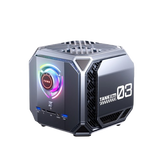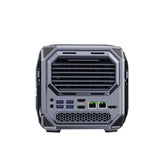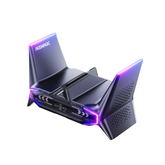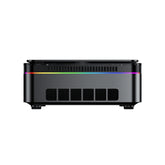iGPU vs dGPU vs eGPU: Choosing the Best Graphics Solution in 2025
In modern computing, graphics processing units (GPUs) play a vital role. Whether it is high-end gaming, video editing, or artificial intelligence training, the performance of the GPU directly affects the efficiency and effectiveness of the task. According to different needs and usage scenarios, GPUs are mainly divided into three types: discrete graphics cards (dGPU), integrated graphics cards (iGPU), and external graphics cards (eGPU). Understanding the differences between these three types of GPUs is crucial to choosing the hardware that suits your needs.
What Is an eGPU?
An eGPU (External GPU) is an innovative solution that breaks free from traditional hardware limitations by connecting a high-performance desktop GPU to portable devices like ultrabooks or mini-PCs via an external dock. Leveraging high-speed interfaces such as Thunderbolt or USB4, it delivers near-desktop-level graphics power in real time, making it ideal for users who need to seamlessly switch between mobile productivity and high-performance tasks. For example, a designer could work on documents using an Ultrabook during the day and plug in an RTX 4070 Ti at night to accelerate 3D rendering, or a gamer could unlock 4K gaming potential on the go through the dock.

The core value of an eGPU lies in its "upgrade-on-demand" flexibility. Users can achieve performance close to a dedicated GPU (with a 10–20% bandwidth penalty) by investing in just the GPU and dock, without replacing their entire system. This is especially critical for Mac users, as Apple’s closed hardware ecosystem makes internal upgrades nearly impossible—eGPUs remain one of the few legal ways to boost graphics performance (e.g., using an AMD Radeon GPU to accelerate Final Cut Pro). Mini-PC users can also bypass size constraints by connecting GPUs directly via Oculink ports, creating compact yet powerful workstations.
However, eGPUs aren’t a perfect solution. Total costs (including the dock, priced at $200–$500, and the GPU) may exceed entry-level desktops. Bandwidth bottlenecks degrade high-FPS 1080p gaming compared to the same GPU installed internally, and compatibility is limited by interfaces and OS restrictions (e.g., macOS only supports AMD GPUs). Think of it as a “performance lifeline” for creative professionals prioritizing portability, budget-conscious users upgrading incrementally, or those needing temporary power boosts—not a replacement for traditional high-end setups.
What Is an iGPU?
An iGPU (Integrated GPU) is a graphics core built directly into a processor or motherboard, sharing the same chip and system memory as the CPU. Requiring no dedicated power supply or extra hardware, it prioritizes low power consumption and cost-effectiveness, making it the go-to choice for lightweight devices like Ultrabooks, mini-PCs, or portable consoles such as the Nintendo Switch. By tapping into the CPU’s resources, iGPUs handle everyday tasks like web browsing, video streaming, and document editing with ease while extending battery life. However, their performance is capped by limited memory bandwidth, struggling with demanding workloads like AAA gaming or professional 3D rendering.

The iGPU’s design philosophy centers on efficiency over raw power. It eliminates the bulk of a dedicated GPU by integrating graphics processing into the CPU itself, shrinking device sizes and reducing thermal strain (think fanless designs like the MacBook Air). While iGPUs can’t match standalone GPUs, modern examples like AMD’s Radeon 780M now deliver surprisingly smooth 1080p gaming in titles like Genshin Impact, blurring the line between integrated and discrete graphics. For users valuing portability, battery life, and practicality—students, remote workers, or casual streamers—iGPUs remain the practical backbone of mobile computing.
What Is a dGPU?
A dGPU (Discrete GPU) is a standalone graphics processor separate from the CPU, featuring its own dedicated VRAM and cooling system. Connected via a PCIe interface, it delivers vastly superior performance compared to integrated graphics (iGPU), tackling heavy workloads like AAA gaming, 4K video rendering, 3D modeling, and AI training. Flagship models like NVIDIA’s RTX 4090 or AMD’s Radeon RX 7900 XTX are powerhouses found in gaming laptops, workstations, and desktop PCs.

Key Features:
- Raw Power for Demanding Tasks: Built to crush 4K gaming, complex 3D simulations, and GPU-accelerated AI workloads.
- Dedicated Memory: Uses fast GDDR6/GDDR6X VRAM, freeing up system RAM for multitasking.
- Power-Hungry Design: Requires robust cooling and external power—high-end models like the RTX 4090 can guzzle over 450 watts.
Further reading: What Is PCI Express (PCIe) and PCIe Slot?
iGPU vs dGPU vs eGPU: Which is Best for Your Needs?
Here’s a detailed comparison of iGPUs (Integrated Graphics), dGPUs (Discrete Graphics), and eGPUs (External Graphics), covering performance, cost, power efficiency, and use cases:
| Category | iGPU (Integrated GPU) | dGPU (Discrete GPU) | eGPU (External GPU) |
|---|---|---|---|
| Purpose | Basic graphics | High-performance graphics | Portability-Performance Hybrid |
| Integration | Built into CPU/motherboard | PCIe slot installation | External dock (Thunderbolt/USB4) or Oculink direct connect |
| Memory | Shared system RAM (no dedicated VRAM) | Dedicated VRAM (GDDR6 / GDDR6X) | Dedicated VRAM (bandwidth-limited by interface) |
| Performance | Low (light tasks) | High (AAA gaming/rendering) | Mid-high (10–20% loss via Thunderbolt; 5–15% via Oculink) |
| Power Draw | Ultra-low (5–30W) | High (75–450W+) | Moderate-high (100–300W with dock; Oculink needs external PSU) |
| Cost | Free (included with CPU) | High (500–500–2,000+ for GPUs) | High ($200+ dock + GPU; Oculink skips dock but needs PSU) |
| Portability | Perfect (no extra gear) | Poor (fixed installation) | Moderate (dock required; Oculink lighter but needs PSU) |
| Compatible Devices | Ultrabooks, office PCs, mini-PCs | Gaming laptops, desktops, workstations | Thunderbolt/USB4/Oculink-enabled laptops or mini-PCs |
| Interface | None | PCIe | Thunderbolt 3/4, USB4, or Oculink (PCIe-based) |
| Cooling Needs | Low (relies on CPU cooling) | High (dedicated fans/heat sinks) | Moderate (built-in dock cooling; Oculink requires DIY) |
| Upgrade Flexibility | Not upgradeable | Swappable (motherboard-dependent) | Swappable (interface/power compatibility required) |
| Ideal Use Cases | Office work, web browsing, streaming | AAA gaming, 4K rendering, AI workloads | Mobile workflows + on-demand power (gaming/creative tasks) |
| Driver Support | Plug-and-play (OS drivers) | Manual driver install (NVIDIA/AMD) | Manual setup (Thunderbolt drivers; Oculink acts like dGPU) |
| Display Efficiency | Direct output (no loss) | Direct output (no loss) | Best with external monitors (Oculink has lower latency) |
Further reading:Liquid Cooling vs Air Cooling: Which Is Better for Your PC?
iGPU vs dGPU vs eGPU: Choose the Right Graphics Solution
iGPUs (Integrated Graphics), dGPUs (Discrete Graphics), and eGPUs (External Graphics) cater to distinct user needs and scenarios.
iGPUs: Built for Portability and Battery Life
iGPUs are ideal for students, remote workers, or anyone prioritizing lightweight devices and all-day battery life. Integrated directly into the CPU with no added cost, they handle everyday tasks like web browsing, document editing, and video streaming effortlessly. Devices like the MacBook Air, RX16 or ACEMAGIC Mini-PCs are perfect for on-the-go use—think studying in a library or working from a café.
AM08 Pro Mini PC with iGPU AMD Radeon 780M
dGPUs: The Powerhouse for Demanding Workloads
dGPUs are engineered for gamers, professional designers, and AI developers. With dedicated VRAM and raw processing muscle, they crush AAA games like Cyberpunk 2077 with ray tracing maxed out, 4K video editing in Premiere Pro, and 3D rendering in Blender. Gaming laptops, high-end desktops, or gaming mini PCs are staples for users needing fixed setups—imagine a pro gamer dominating at home or a designer rendering complex scenes in a studio.
eGPUs: Flexibility Meets Performance
eGPUs strike a balance for users who switch between mobility and power. By connecting a GPU dock (via Thunderbolt/USB4/Oculink) to an Ultrabook or mini-PC, you get desktop-tier performance on demand. For example, a creator could edit videos on a MacBook Pro by day and plug in an AMD Radeon GPU at night to speed up Final Cut Pro exports. Similarly, a gamer could travel with a lightweight laptop and hook up an RTX 4070 at a hotel for a premium gaming session. However, eGPUs come with added costs for the dock and GPU, plus a 10–20% performance hit over Thunderbolt (less with Oculink).
The Bottom Line:
- Ideal for students, remote workers, or anyone prioritizing battery life and portability. Choose iGPUs if portability and battery life are non-negotiable.
- The go-to for gamers, 3D artists, or AI developers needing uncompromised power. Go dGPU for max performance in gaming, rendering, or AI.
- Opt for eGPU if you need occasional power boosts without sacrificing mobility.
FAQs
What are the main differences between iGPUs, dGPUs, and eGPUs?
- iGPU (Integrated GPU): Built directly into the CPU, sharing system RAM. It offers low power consumption and is ideal for basic tasks like web browsing, video streaming, and document editing.
- dGPU (Discrete GPU): A standalone graphics card with dedicated VRAM and high performance, perfect for demanding applications like gaming, 3D rendering, and video editing.
- eGPU (External GPU): An external graphics solution that connects via Thunderbolt or USB4, allowing laptops or mini-PCs to access desktop-level GPU power. It offers flexibility for users who need occasional high-performance boosts.
Which GPU type is best for gaming?
For serious gaming, a dGPU is the best choice due to its dedicated resources and high performance, supporting high frame rates and advanced graphics settings. An eGPU can be a good option if you need portability combined with the ability to game at higher settings when docked. An iGPU is suitable for casual or older games but may struggle with modern, graphically intense titles.
Can an eGPU match the performance of a dGPU installed internally?
An eGPU can provide close to the performance of a dGPU, but there is typically a 10–20% performance penalty due to bandwidth limitations when using Thunderbolt connections. Oculink connections can reduce this penalty to about 5–15%. While not identical, an eGPU still offers a significant performance boost over an iGPU, making it a strong contender for users who need flexible, on-demand power.
What are the cost considerations for each GPU type?
- iGPU: Comes integrated with the CPU, so there's no additional cost beyond the processor itself, making it the most cost-effective for basic tasks.
- dGPU: Can range from a few hundred to several thousand dollars, depending on the model and performance, plus the cost of a compatible system with sufficient cooling and power.
- eGPU: Requires investment in both the GPU and an external dock, which can add $200–$500 for the dock alone, making it a significant but flexible investment for enhancing graphics performance on existing devices.
Are eGPUs compatible with all laptops and mini-PCs?
No, eGPUs are not universally compatible. They require specific high-speed interfaces like Thunderbolt 3/4 or USB4, and some operating systems, like macOS, have limitations. It's essential to check your device’s compatibility and ensure it has the necessary ports and software support before investing in an eGPU setup.








Leave a comment
Please note, comments need to be approved before they are published.